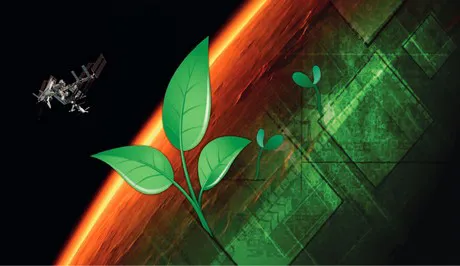Norwegian Time Scale scientist Ann-Iren Kittang Jost is involved in one of the next experiments on the International Space Station called “Water Across Plants”, where they will grow mung bean. The aim is to study the effect of weightlessness on morphology and physiological traits of plant organs associated with the water flow pathway across the whole plant. "There will most likely be more experiments performed on crops under weightlessness but also characterization studies and system development on crops on Earth to prepare for life support systems to be used on a more permanent base for humans on the Moon."

Manipulated illustration of ISS, Mars and sprouts, based on photos from NASA/ESA and Colourbox (NTNU Social Research).
As for Earth, Ann-Iren believes the focus will be on sustainable food production and food security. "This has strong synergies with closed loop systems for space exploration. Our experience also clearly shows that crop cultivation in space is an inspiration for younger generations and a driver for innovation and sustainable food production here on Earth."
Mars and the Moon
For Wageningen University it will be hard to keep contributing due to EU budget cuts, and the Dutch government does not invest in life science for space exploration. Other countries will continue to work on this via ESA projects (e.g. Melissa) and several German (DRL) and American (NASA) projects. "It's a shame that the Dutch government has decided not to invest in this branch of research", Leo Marcelis and Sander van Delden of Wageningen University comment, "as looking at horticulture from a space perspective will gain fundamentally new insights that are often directly applicable for greenhouses on earth. It is also a very nice vehicle to maintain and market the high knowledge levels we have in the Dutch horticultural sector. It creates a lot of publicity, but as funding has stopped, this line of research will also disappear in the Netherlands."
But although some research steps still need to be taken, the potential to have optimal plant growth with very limited resources in almost any place in the Universe are certainly within reach, according to Leo and Sander. "That is possible as long as we use a growth chamber that is thick enough to protect plants from space radiation and is not melting or deteriorated by hostile atmospheres. Mars and Moon are nice examples of places where plants can certainly grow if we develop and ship the right equipment."
Not only in space resources are limited. Also on earth regulations make it harder for growers to maintain current practices, and thus continuous innovation is required. "The current and future lines research of our chair group (HPP) on vertical farming and LED lighting will certainly help to support the horticultural sector during the coming challenges", Leo and Sander tell us.
Precision agriculture, vertical farms
Roy O'Mahony of CleanGrow sees a lot of potential for the further development of data-driven precision agriculture: "I think precision agriculture driven by data is already here and will only get better as equipment improves and especially systems to utilize the new data now achievable. We have more people to feed and less resources, especially phosphate for example, so we have to be careful. This should also help with increasing or supporting the small margins in the industry as well so it is a win win situation."
CleanGrow is also responding to the massive expansion of vertical/urban farming projects appearing almost daily. The company is working with a few newly venture backed firms such as plenty.ag and Bowery Farming. Mainly at this stage most of these companies are only growing leafy greens, lettuce and herbs. "While it will not feed the world, it is an interesting trend and with innovation could expand further into new realms", Roy expects. "Perhaps the non-food branch of horticulture, plant derived chemicals and botanical derived cosmetics, not forgetting the emerging medical and recreational cannabis market in the United States."
At CleanGrow, they're continuously looking to develop new and better products and exploring new ideas with partners in companies and research institutes. They have just kicked off a new ERDF small grant with Rothamsted plant research in North Wyke Devon. The project is based around using their new phosphate sensor on soils in the Cornwall region. "Rothamsted has years of experience and data for all sorts of soil types with respect to measuring P content. We will at the end hopefully have a solid protocol to use our P kit for every possible soil type so the end user will not have to work anything out, just use the probe and get reliable cheap P data for their farm."
Roy says they are also working to get further funding to get a flight-ready version of the auto-analyzer and get it into space for experiments on the International Space Station.
Dominique Van Der Straeten of Ghent University also expects proceeds from the Time Scale project can have applications on earth. Specifically, she thinks the research into miniaturization of imaging technology and the use of SIFT-MS technology and gas chromatography to analyze volatile signaling molecules will be practically useful, calling the technology developed by Van Der Straeten and Joeri Vercammen (of InterScience Belgium) a "cornerstone for precision agriculture".
Time Scale follow-up?
And what about the future of the Time Scale project? Because of the success of the project early on there was a follow-up planned by the EU, but this was recently cancelled because of political issues and budget cuts. As a spin-off, Wageningen University wrote a project proposal together with Eindhoven University to do further research on capturing nitrogen from the air (plasma techniques) and feeding that in low doses to plants in greenhouses. They will hear this month if that project gets funded.
For more information:
 TIME SCALE
TIME SCALEtimescale.eu
